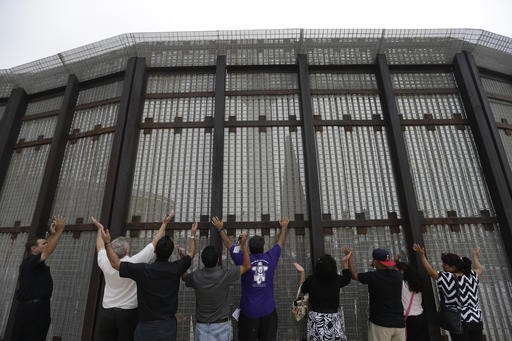Popular Reads
Top Results
Can't find what you're looking for?
View all search resultsPopular Reads
Top Results
Can't find what you're looking for?
View all search resultsReport shows big increase in people seeking asylum on border
Change text size
Gift Premium Articles
to Anyone
 In this July 14, 2013, file photo, pastors and others raise their arms on the San Diego side of a border fence during a cross-border Sunday religious service with others on the Tijuana, Mexico side of the fence. Barely half of immigrants who entered the country illegally on the U.S. border with Mexico last year got caught. That's according to an internal Department of Homeland Security report obtained by The Associated Press Oct. 6, 2016. (AP/Gregory Bull)
In this July 14, 2013, file photo, pastors and others raise their arms on the San Diego side of a border fence during a cross-border Sunday religious service with others on the Tijuana, Mexico side of the fence. Barely half of immigrants who entered the country illegally on the U.S. border with Mexico last year got caught. That's according to an internal Department of Homeland Security report obtained by The Associated Press Oct. 6, 2016. (AP/Gregory Bull)
H
undreds of thousands of people have sought asylum along the US-Mexico border in the last two years, a dramatic increase that shows how migrants have changed from mostly Mexican men trying to evade capture to more Central American families who often turn themselves in, a report for the federal government shows.
Asylum seekers, many of them fleeing drug-fueled violence south of the border, peaked in 2014 at 170,000, nearly triple the 63,000 who arrived the previous year. Before 2012, there were fewer than 30,000 a year.
In the 2015 fiscal year, the number declined to 140,000 people, according to the report by the Institute for Defense Analyses, a federally funded research organization that was tapped to help develop new measures of border security. The Associated Press obtained a copy of the report from a government official involved in border issues who acted on condition of anonymity because it has not been made public.
"The dramatic increase in asylum seekers since 2011 may represent a structural change in illegal entry behavior at the southern border," the report said. "This trend is driving significant changes in how to enforce immigration laws and the demands for resources for enforcement."
The number of asylum seekers spiked well after the US launched a major expansion in enforcement, erecting hundreds of miles of fences, adding surveillance gear and doubling the size of the Border Patrol.
The spike highlights the need to address other aspects of the immigration system, such as the courts and the Department of Health and Human Services, which supervises unaccompanied children, said David Aguilar, who led the Border Patrol from 2004 to 2010.
"There's a new border environment that we, as a country, need to address," Aguilar said. "The border environment that I took over as chief in 2004 is very different than what we see today."
The report's authors did not include asylum seekers in their calculation of how many people are apprehended at the border. That is in contrast to the Homeland Security Department, which counts them.
The different approaches help explain why the report found that 54 percent of people trying to enter the country illegally between Mexico border crossings got caught last year. That's much lower than the government's publicly stated success rate of 81 percent.
Rep. Martha McSally, an Arizona Republican who has pressed Homeland Security officials to release the report, said the 54 percent figure was no surprise.
"Given that DHS knows these facts, they need to stop pushing misleading measurements that don't show the full picture and create mistrust with the American public," she said.
The Homeland Security Department began releasing its "interdiction effectiveness rate" two years ago — 81 percent last year and 79 percent in 2014. It also includes people who set foot in the country and turned back. The most recent report does not include them.
The authors caution that the number of asylum seekers cannot be counted precisely and was calculated using categories of people most closely associated with those claims, including unaccompanied children from countries other than Mexico.
Homeland Security officials said Thursday that the report was "one building block provided by a research organization" toward developing more reliable measures of border security and that its methodology needed refinement.
The report showed a dramatic decline in the number of people who eluded capture — 200,000 in 2015 compared with 1.9 million in 2005. The drop coincides with increases in spending on border enforcement to $14 billion a year and the introduction of tougher penalties for people who get caught, including jail time.
"This is the first solid evidence we have that the border buildup of the last 20 years has indeed made some significant difference in deterring and reducing illegal entries across the southern border," said Edward Alden, senior fellow at the Council on Foreign Relations.









